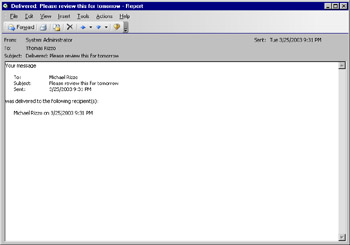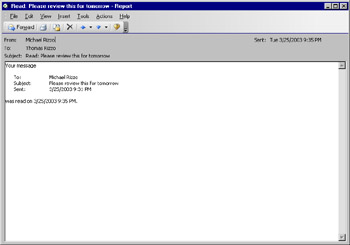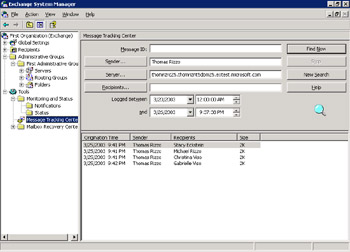Exchange Messaging Infrastructure
The Exchange Server messaging infrastructure provides certain core services that enable you to focus on developing value-added services rather than essential ones. This infrastructure complements current network topologies and protocols and, as you'll see, guarantees that every message gets through to its destination. The following sections discuss some of the advantages of the Exchange Server messaging infrastructure.
Least-Cost Routing, Load Balancing, and Failover
Technologies in the Exchange Server messaging engine allow organizations to define different communication routes between Exchange servers. Costs can be assigned to these different routes, and the least costly route is always attempted first by the Exchange server. If this route is not available, Exchange Server will fail over to the next least costly route. If you assign the same cost to two routes, Exchange Server will distribute the communications traffic evenly over both routes, thereby load balancing the connections.
Let's look at an example. Imagine a network with three routes between an Exchange server in New York and an Exchange server in California. One route communicates over a wide area network (WAN), the second over a dial-up 28.8 modem, and the third over a satellite link. The administrator of the Exchange Server system assigns costs to each of these routes: the WAN route is assigned a cost of 20, the modem route a cost of 50, and the satellite route a cost of 70. Based on the cost of the routes, the Exchange Server system will always attempt the WAN route first. If this route is down, Exchange Server will fail over to the next least-costly route, the modem; if that route is unavailable, it will attempt to connect over the satellite.
This is just a simple example; Exchange Server supports very complex routing tables with associated costs that it automatically calculates. For example, consider a message that has to be routed through seven Exchange servers until it reaches its final destination. Each Exchange server has three unique routes to the next server. Exchange Server automatically finds the least costly route among all the routes supplied.
Delivery and Read Receipts
Exchange Server supports both delivery and read receipts when delivering information through an Exchange Server system. Delivery receipts are returned to an individual user or an application when an item has been delivered to its final destination. This destination can be another Exchange server or a messaging server over the Internet. A delivery receipt also reports the time and date that an item was received by a particular system. You can use delivery receipts in your applications to trigger events when they are returned. For example, a workflow application can consolidate delivery receipts to track the status of message delivery to workflow participants . Figure 2-1 shows an example of a delivery receipt.

Figure 2-1: A delivery receipt sent back to a user
Read receipts, which are similar to delivery receipts, are sent to a user or an application when the recipient actually opens the item. You might use read receipts in your application for time-sensitive items sent through the Exchange Server system. The application can track when an item is read, and if no action is taken after a certain amount of time, it can reroute the item to a different user or application. Figure 2-2 shows an example of a read receipt.

Figure 2-2: Applications using read receipts to track when users open items sent by the application
Message Tracking
Exchange Server supports more than delivery and read receipts. When message tracking is enabled, Exchange Server keeps logs of the items that have entered the Exchange Server system from other systems. You can trace any item in your application to determine if it reached its destination.
Exchange Server also logs where items were routed, which Exchange Server components routed them, and when the items were delivered to their final destination. Message tracking enables you to find an item's route based on criteria such as the sender of the item, the intended recipient, or even the component of Exchange Server that handled the message. Figure 2-3 shows the Exchange Server Message Tracking Center interface.

Figure 2-3: Tracking items from Thomas Rizzo across the Exchange Server system
EAN: 2147483647
Pages: 227